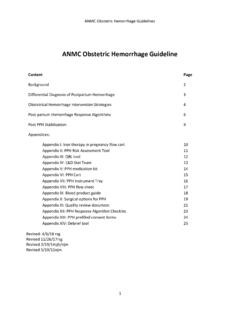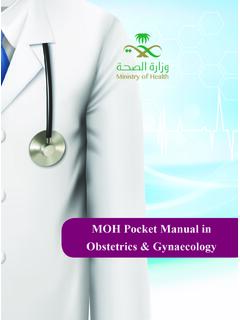Transcription of DEPARTMENT OF HEALTH & HUMAN SERVICES Centers for …
1 Page 1 of 4 DEPARTMENT OF HEALTH & HUMAN SERVICES Centers for Medicare & Medicaid SERVICES 7500 Security Boulevard, Mail Stop C2-21-16 Baltimore, Maryland 21244-1850 Center for Clinical Standards and Quality Ref: QSO-22-05-Hospitals (ADVISORY) DATE: December 7, 2021 TO: State Survey Agency Directors FROM: Directors, Quality, Safety & Oversight Group (QSOG) and Survey & Operations Group (SOG) SUBJECT: Evidence-based best practices for hospitals in managing obstetric emergencies and other key contributors to maternal HEALTH disparities Memorandum Summary The Condition of Participation for Quality Assessment and Performance Improvement Program ( ) requires that hospitals develop, implement, and maintain an effective, ongoing, hospital wide, data-driven quality assessment and performance improvement program. CMS is encouraging hospitals to consider implementation of evidence-based best practices for the management of obstetric emergencies, along with interventions to address other key contributors to maternal HEALTH disparities, to support the delivery of equitable, high-quality care for all pregnant and postpartum individuals.
2 Background Each year in the , approximately 700 women die from pregnancy-related complications, and over 25,000 survive having experienced severe complications of pregnancy (severe maternal morbidity).1,2 Furthermore, racial, ethnic, and geographic disparities intensify the nation s maternal HEALTH crisis. Black and Indigenous women die from pregnancy-related causes at a rate 2-3 times higher3 and experience severe maternal morbidity at a rate nearly two times higher2 than their White, Asian Pacific Islander, and Hispanic counterparts. Pregnant women who live in rural communities are at higher risk for severe maternal morbidity and about 60 percent more likely to die before, during, or after delivery than those living in urban Yet, two out of three 1 Emily E. Petersen et al. Vital Signs: Pregnancy-Related Deaths, United States, 2011-2015, and Strategies for Prevention, 13 States, 2013-2017.
3 MMWR Morb Mortal Wkly Rep 2019;68:423-29. 2 Maternal and Child HEALTH Bureau. Federally Available Data (FAD) Resource Document. HEALTH Resources and SERVICES Administration. Available at: Accessed November 10, 2021. 3 Centers for Disease Control and Prevention. Pregnancy Mortality Surveillance System. Available at: Accessed November 10, 2021. Accessed November 10, 2021. 4 Governmental Accountability Office WatchBlog. The Additional Risks and Challenges for Pregnant Women in Rural and Underserved Communities. Available at: Page 2 of 4 pregnancy-related deaths are considered As one part of the solution, systematic quality improvement (QI) efforts are underway in hospitals across the country to not only enhance the quality and safety of maternity care, but also reduce the disparity gap in maternal HEALTH outcomes. Facilities are participating in local/regional perinatal quality collaboratives (PQCs), application of early warning sign tools, and especially, use of patient safety bundles.
4 6,7 The Institute for Healthcare Improvement defines bundles as a small, straightforward set of evidence-based practices that, when performed collectively and reliably, have been demonstrated to improve patient outcomes. 8 Maternal safety bundles, often implemented through PQCs, have demonstrated success in driving improvements, particularly with regards to obstetric hemorrhage , severe hypertension in pregnancy, and non-medically indicated Cesarean ,10,11 Additionally, the racial disparity gap in certain perinatal outcomes has shown modest narrowing in association with hospital participation in bundle implementation and related QI Maternal Safety Bundles There are various frameworks in the design and implementation of bundles for maternal safety. One rubric employed by the Alliance for Innovation on Maternal HEALTH (AIM), a program implemented by the American College of Obstetricians and Gynecologists (ACOG) with funding from the HEALTH Resources and SERVICES Administration (HRSA), organizes evidence-based recommendations for patient safety bundles into four domains, or the four R s : 1) Readiness, 2) Recognition and Prevention, 3) Response, and 4) Reporting and Systems For example, some of the AIM bundle recommendations for responding to obstetric hemorrhage include: 1.
5 Readiness hemorrhage cart with the necessary supplies 2. Recognition and Prevention Measurement of cumulative blood loss 3. Response Standardized emergency management plan for obstetric hemorrhage 4. Reporting and Systems Learning Multi-disciplinary review of serious cases This framework is meant to guide facilities in identifying key opportunities for improvement, such as the need to partner with other local and/or regional HEALTH systems to assist with patient transfer 5 Nicole L. Davis et al. Pregnancy-Related Deaths: Data from 14 Maternal Mortality Review Committees, 2008-2017. Atlanta, GA: Centers for Disease Control and Prevention, DEPARTMENT of HEALTH and HUMAN SERVICES ; 2019. Available at: Accessed November 10, 2021. 6 Catherine Squire Eppes et al. Enhancing Obstetric Safety Through Best Practices. J Women s HEALTH 2021;30(2):265-69.
6 7 Roy Ahn et al. Initiatives to Reduce Maternal Mortality and Severe Maternal Morbidity in the United States. Ann Intern Med 2020;173:S3-10. 8 Institute for Healthcare Improvement. What is a Bundle? Available at: Accessed October 27, 2021. 9 Jennifer A. Callaghan-Koru et al. Implementation of the Safe Reduction of Primary Cesarean Births safety bundle during the first year of a statewide collaborative in Maryland. Obstet Gynecol 2019;134:109 19. 10 Elliott K. Main et al. Reduction of severe maternal morbidity from hemorrhage using a state perinatal quality collaborative. Am J Obstet Gynecol 2017;216(3) 11 Patricia Lee King et al. Reducing time to treatment for severe maternal hypertension through statewide quality improvement. Am J Obstet Gynecol 2018;218:S4. 12 Elliott K. Main et al. Reduction in racial disparities in severe maternal morbidity from hemorrhage in a large-scale quality improvement collaborative.
7 Am J Obstet Gynecol 2020;223 13 Alliance for Innovation on Maternal HEALTH . Patient Safety Bundles. Available at: #core. Accessed November 1, 2021. Page 3 of 4 to higher levels of care, as appropriate. In addition, recognizing the importance of threading a HEALTH equity lens throughout implementation of all bundles, the AIM program recently added a fifth R as well: Respectful, Equitable, and Supportive Care. This domain has already been incorporated into several new AIM bundles,14,15,16 and will be added with revisions to earlier bundles including for both obstetric hemorrhage and severe hypertension in pregnancy beginning in 2022. Generally, key lessons learned in support of effective bundle adoption and dissemination of associated QI strategies include: identifying institutional champions and building consensus across disciplines; tailoring strategies to local context and culture; engaging in ongoing iteration, training, and technical assistance; facilitating access to rapid-cycle data to measure and analyze progress.
8 And, preparing for incremental scale-up to sustain positive , 17,18,19,20 Notably, in light of the growing body of evidence for obstetric QI strategies, particularly around prevention, early recognition, and timely treatment for maternal hemorrhage and severe hypertension/preeclampsia, The Joint Commission released new elements of performance (EPs) to improve quality and safety in maternity On January 1, 2021, these perinatal EPs took effect among Joint Commission-accredited hospitals. Maternal Morbidity Structural Measure Beginning with October 1, 2021 discharges, CMS adopted a new structural quality measure for the Hospital Inpatient Quality Reporting (IQR) Program that asks hospitals to attest to whether they participate in a statewide and/or national maternal safety quality collaborative, and whether they have implemented patient safety practices or bundles to improve maternal outcomes.
9 Specifically, hospitals participating in the Hospital IQR Program that provide inpatient peripartum care will be required to respond to the following questions for the fourth quarter of 2021 and then, beginning in 2022, on an annual basis: Does your hospital or HEALTH system participate in a Statewide and/or National Perinatal Quality Improvement Collaborative Program aimed at improving maternal outcomes during inpatient labor, delivery and postpartum care, and has implemented patient safety practices or bundles related to maternal morbidity to address complications, including, but not limited to, hemorrhage , severe hypertension/preeclampsia or sepsis? 14 Alliance for Innovation on Maternal HEALTH . Cardiac Conditions in Obstetrical Care. Available at: Accessed November 4, 2021. 15 Alliance for Innovation on Maternal HEALTH . postpartum Discharge Transition.
10 Available at: Accessed November 4, 2021. 16 Alliance for Innovation on Maternal HEALTH . Care for Pregnant and postpartum People with Substance Use Disorder. Available at: Accessed November 4, 2021. 17 Fouad Atallah and Dena Goffman. Bundles for Maternal Safety: Promises and Challenges of Bundle Implementation: The Case of Obstetric hemorrhage . Clin Obstet Gynecol 2019; 62(3):539-49. 18 Daniel M. Walker et al. Designing quality improvement collaboratives for dissemination: lessons from a multiple case study of the implementation of obstetric emergency safety bundles. The Joint Commission Journal on Quality and Patient Safety 2020;46:136-45. 19 Daniel M. Walker et al. Barriers and facilitators to hospital implementation of obstetric emergency safety bundles: a qualitative study. J Hosp Manag HEALTH Policy 2021;5:3. 20 Elliott K. Main et al. Addressing maternal mortality and morbidity in California through public-private partnerships.














